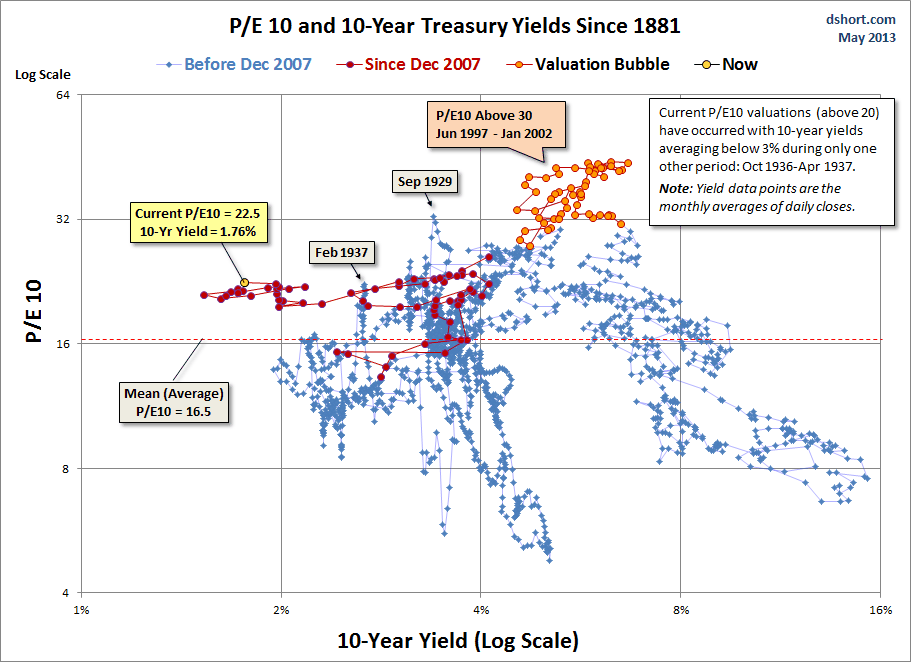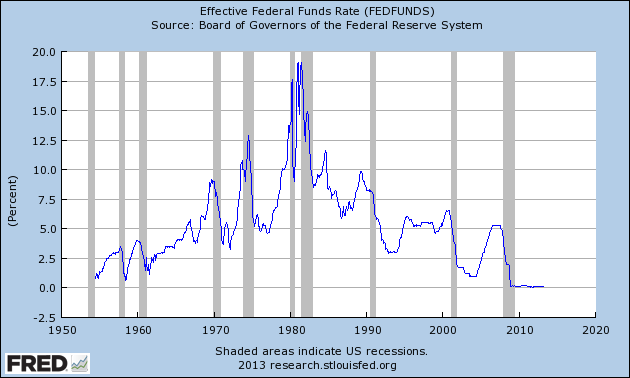My monthly market valuation updates have long had the same conclusion: US stock indexes are significantly overvalued, which suggests cautious expectations on investment returns. In a "normal" market environment -- one with normal business cycles, Federal Reserve policy, interest rates and inflation -- current valuation levels would be a serious concern.
But these are different times. The economic cycle shaped by the Financial Crisis that began emerging in 2007 shortly after the Bear Stearns hedge funds collapsed. The Fed began its historic crusade in cutting the overnight rate from an average of 5.25% prior to the hedge fund collapse to ZIRP (Zero Interest Rate Policy) as of December 16, 2008. The bankruptcy of Lehman Brothers on September 15, 2008 was the most dramatic precipitator of the Fed's unprecedented policies.
In the wake of the Financial Crisis, inflation has been low and the 10-year Treasury yield is hovering about 30 basis points above its historic closing low of 1.43% set on July 25, 2012. So, with this refresher on the Financial Crisis in mind, let's take another look at the popular P/E10 valuation metric.
Here is a scatter graph with the market valuation on the vertical axis (log scale) and interest rates on the horizontal axis. I've included some key highlights: 1) the extreme overvaluation of the Tech Bubble, 2) the valuations since the start of last recession, 3) the average P/E10 and 4) where we are today.
The inflation "sweet spot", the range that has supported the highest valuations, is approximately between 1.4% and 3%. For example I've highlighted the extreme valuations associated with the Tech Bubble arbitrarily as a P/E10 at 30 and higher. The chronology of the orange "bubble" on the chart is a clockwise loop of 56 months starting at the 6 o'clock position. The P/E10 was 31.3 and the annual inflation rate for that month, June 1997, was 2.30%. The average inflation rate for the loop was 2.41%. The P/E10 peak of 44.2 in December 1999 was accompanied by a 2.68% annual inflation rate. Two months later the inflation rate topped 3% at 3.22%. The right side of the loop shows what happened thereafter. The ratio slipped below 30 for two months (the tail at the bottom of the loop) before its final three-month swan song in the 30+ range.
The latest P/10 valuation of 22.5 is at the 68th percentile of valuations in the 1.4%-to-3% inflation sweet spot. If we exclude Tech Bubble P/E10 valuations above 30 on the grounds of temporary insanity ("Irrational Exuberance"), the percentile of the latest valuation moves up to the 77th.
And speaking of that 30 threshold for the P/E10, prior to the Tech Bubble, only two months in history had a ratio above 30: They were 31.5 and 32.6 in August and September of 1929, just before the Crash of 1929. Research estimates put the annual inflation rate during those two months at 1.17% and 0.00% (zero).
P/E10 and the 10-Year Treasury Yield
A question I'm often asked is whether a valuation metric such as the P/E10 has any merit in a world with Treasury yields at current levels. Investors who require portfolio growth might indeed be motivated to disregard historic indicators that warn of an overvalued market. But what does history show us about the correlation between the P/E10 and the 10-year constant maturity yield? The next scatter graph offers some clues. The horizontal axis has been switched to the 10-year yield. I've used a log scale to better illustrate the relative yields values.
Essentially we are in "uncharted" territory. Never in history have we had 20+ P/E10 ratios with yields in the low 2% and lower range. The closest we ever came to this in US history was a seven-month period from October 1936 to April 1937. During that timeframe the 10-year yield averaged 2.67%, about 65 basis points above where we are now. How did the market fare? The S&P Composite hit an interim high (based on monthly averages of daily closes) in February 1937. The index plunged 44.9% over the next 15 months.
If we look to the Dow daily closes during that period, the index hit an interim high on March 3, 1937 and fell 49.1% to an interim trough on March 31, 1938 -- 13 months later.
What can we conclude? As I said above, we're in "uncharted" territory. Fed easing will keep yields in the basement for a prolonged period, thus promoting a risk-on skew to investment strategies despite their weak fundamentals. On the other hand, we could see a strongly negative market reaction to more bungling of US debt management. We could also see exogenous shocks from the euro zone, Asia or the Middle East that could give investors second thoughts about equities. Yet another possibility is that economic improvements abroad could make international markets more attractive than US equities.
We are indeed living in interesting times.
Note: For readers unfamiliar with the S&P Composite index, see this article for some background information.
Note: I've updated the charts in this commentary to include the latest monthly data.
To support my characterization of the current Effective Federal Funds Rate as "unprecedented", here is a snapshot of the complete FFR history from the FRED repository.
- English (UK)
- English (India)
- English (Canada)
- English (Australia)
- English (South Africa)
- English (Philippines)
- English (Nigeria)
- Deutsch
- Español (España)
- Español (México)
- Français
- Italiano
- Nederlands
- Português (Portugal)
- Polski
- Português (Brasil)
- Русский
- Türkçe
- العربية
- Ελληνικά
- Svenska
- Suomi
- עברית
- 日本語
- 한국어
- 简体中文
- 繁體中文
- Bahasa Indonesia
- Bahasa Melayu
- ไทย
- Tiếng Việt
- हिंदी
Market Valuation, Inflation And Treasury Yields: Clues From The Past
Published 05/02/2013, 07:56 AM
Updated 07/09/2023, 06:31 AM
Market Valuation, Inflation And Treasury Yields: Clues From The Past
3rd party Ad. Not an offer or recommendation by Investing.com. See disclosure here or
remove ads
.
Latest comments
Install Our App
Risk Disclosure: Trading in financial instruments and/or cryptocurrencies involves high risks including the risk of losing some, or all, of your investment amount, and may not be suitable for all investors. Prices of cryptocurrencies are extremely volatile and may be affected by external factors such as financial, regulatory or political events. Trading on margin increases the financial risks.
Before deciding to trade in financial instrument or cryptocurrencies you should be fully informed of the risks and costs associated with trading the financial markets, carefully consider your investment objectives, level of experience, and risk appetite, and seek professional advice where needed.
Fusion Media would like to remind you that the data contained in this website is not necessarily real-time nor accurate. The data and prices on the website are not necessarily provided by any market or exchange, but may be provided by market makers, and so prices may not be accurate and may differ from the actual price at any given market, meaning prices are indicative and not appropriate for trading purposes. Fusion Media and any provider of the data contained in this website will not accept liability for any loss or damage as a result of your trading, or your reliance on the information contained within this website.
It is prohibited to use, store, reproduce, display, modify, transmit or distribute the data contained in this website without the explicit prior written permission of Fusion Media and/or the data provider. All intellectual property rights are reserved by the providers and/or the exchange providing the data contained in this website.
Fusion Media may be compensated by the advertisers that appear on the website, based on your interaction with the advertisements or advertisers.
Before deciding to trade in financial instrument or cryptocurrencies you should be fully informed of the risks and costs associated with trading the financial markets, carefully consider your investment objectives, level of experience, and risk appetite, and seek professional advice where needed.
Fusion Media would like to remind you that the data contained in this website is not necessarily real-time nor accurate. The data and prices on the website are not necessarily provided by any market or exchange, but may be provided by market makers, and so prices may not be accurate and may differ from the actual price at any given market, meaning prices are indicative and not appropriate for trading purposes. Fusion Media and any provider of the data contained in this website will not accept liability for any loss or damage as a result of your trading, or your reliance on the information contained within this website.
It is prohibited to use, store, reproduce, display, modify, transmit or distribute the data contained in this website without the explicit prior written permission of Fusion Media and/or the data provider. All intellectual property rights are reserved by the providers and/or the exchange providing the data contained in this website.
Fusion Media may be compensated by the advertisers that appear on the website, based on your interaction with the advertisements or advertisers.
© 2007-2024 - Fusion Media Limited. All Rights Reserved.
